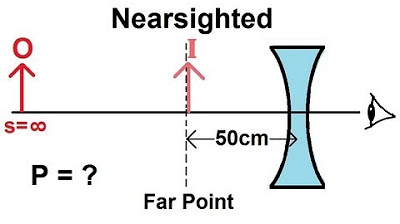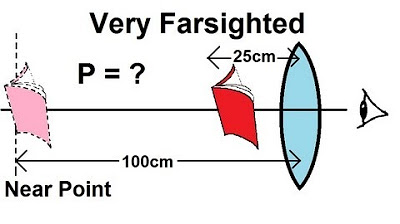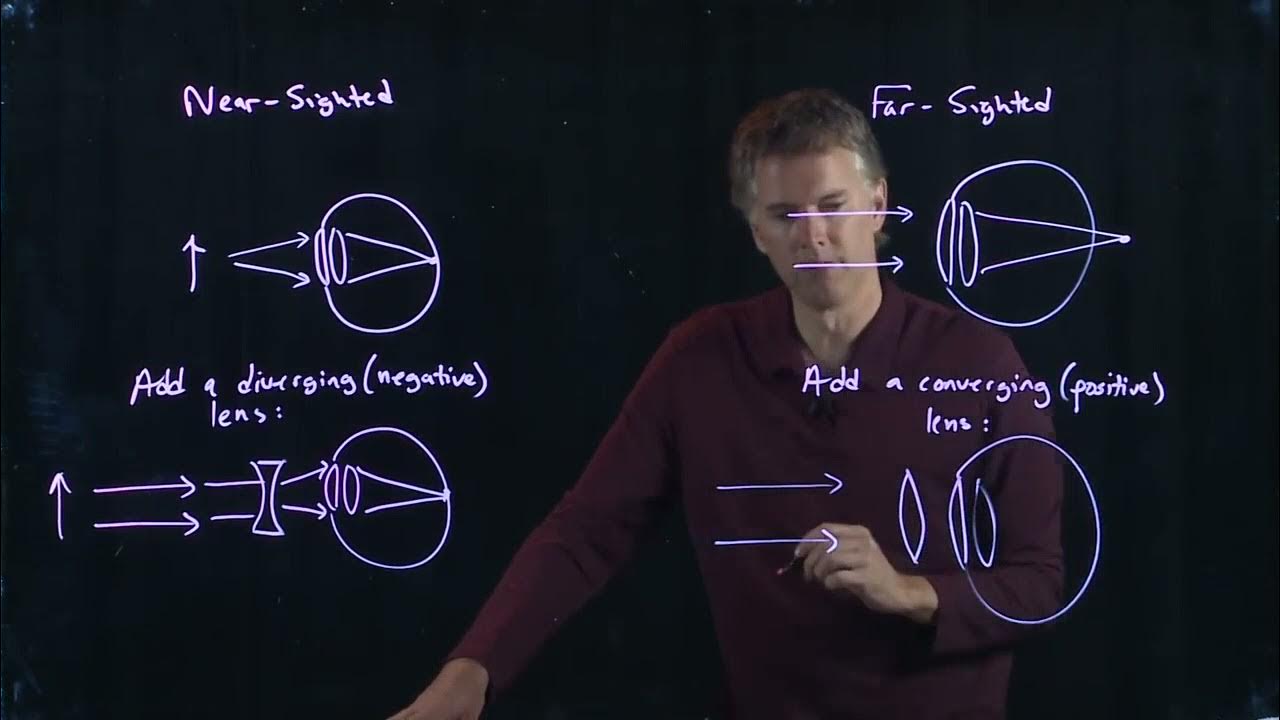Contact Lenses | Physics with Professor Matt Anderson | M28-21
TLDRThe script discusses a vision problem of Alice, who is farsighted, unable to see objects closer than 80 cm. To correct this and enable her to see objects at 25 cm comfortably, the script explains the concept of using contact lenses with the right refractive power. It details the calculation of the power needed for the contact lens, involving the lensmaker's equation and the concept of lens power in diopters. The final calculation suggests a lens power of approximately 2.8 diopters, with a close match to answer choice B, 2.75 diopters.
Takeaways
- 👓 Alice is farsighted, meaning she can see distant objects clearly but struggles with close-up vision.
- 🔍 The refractive power of contact lenses is measured in diopters, which is the reciprocal of the focal length in meters.
- 📏 Alice's eyes naturally focus objects at a distance of 80 centimeters onto her retina, but not closer than that.
- 🤔 To help Alice see objects at 25 centimeters, a positive lens is needed to correct her vision.
- 👁 The power of Alice's eye without correction is calculated using the lens maker's formula, considering the image distance and object distance.
- 🧮 The calculation involves adding the reciprocals of the focal lengths (powers) of the eye and the contact lens.
- 📐 The initial calculation of the eye's power gives a result close to 41.2 diopters, which is the power of Alice's bare eyeball.
- 🆕 With the contact lens, the new system's power is calculated to be around 44 diopters, considering the new object distance of 25 centimeters.
- ➕ The power of the contact lens alone is found by subtracting the power of the bare eyeball from the combined system's power, resulting in approximately 2.8 diopters.
- 📝 The contact lens prescription would be a positive number, such as +2.8 or +2.75, indicating the additional power provided by the lens.
- 👁️💻 The process demonstrates the practical application of optical principles in correcting vision with contact lenses for individuals with farsightedness.
Q & A
What is the main issue with Alice's eyesight as described in the transcript?
-Alice is farsighted, which means she can see distant objects clearly but has difficulty seeing objects that are closer to her eye than 80 centimeters.
What is the purpose of the contact lenses in this scenario?
-The contact lenses are intended to correct Alice's farsightedness, allowing her to comfortably see objects at a distance of 25 centimeters from her eye.
Why are positive lenses used to correct farsightedness?
-Positive lenses are used because they converge light rays, helping to focus the image on the retina for someone who is farsighted and normally sees distant objects clearly.
What is the concept of 'power' in the context of lenses?
-In the context of lenses, 'power' refers to the ability of a lens to converge or diverge light rays, and it is measured in diopters, which is the reciprocal of the focal length in meters.
How does the addition of a contact lens affect the overall power of the eye-lens system?
-When a contact lens is added to the eye, the overall power of the eye-lens system is the sum of the powers of the contact lens and the eye itself. This is because the powers of lenses are additive when they are in series.
What is the significance of the image distance in this problem?
-The image distance is the distance from the lens to the image formed by the lens. In this problem, the image distance is the size of the eyeball, which is 25 millimeters, and it's crucial for calculating the power of the eye and the required lens.
What is the formula used to calculate the power of the eye in this scenario?
-The formula used to calculate the power of the eye is \( \frac{1}{f} = \frac{1}{d_o} + \frac{1}{d_i} \), where \( f \) is the focal length of the eye, \( d_o \) is the object distance, and \( d_i \) is the image distance.
What is the calculated power of Alice's bare eyeball based on the given information?
-The calculated power of Alice's bare eyeball is approximately 41.2 diopters, based on the given object and image distances.
How is the power of the contact lens determined?
-The power of the contact lens is determined by the difference between the combined power of the contact lens and the eye and the power of the eye alone. In this case, it is \( 44 - 41.2 \) diopters.
What is the approximate power of the contact lens needed for Alice to see objects at 25 centimeters?
-The approximate power of the contact lens needed for Alice is 2.8 diopters, which is a positive value indicating a converging lens.
Why is the final answer rounded to 2.75 diopters in the transcript?
-The final answer is rounded to 2.75 diopters likely due to rounding or approximation in the calculation process to match standard lens prescription values.
Outlines
👓 Understanding Alice's Farsightedness and Lens Power Calculation
The script begins by introducing a problem involving Alice, who is farsighted and unable to see objects closer than 80 centimeters. The objective is to determine the refractive power of contact lenses that would allow her to see objects at 25 centimeters comfortably. The explanation delves into the concept of lenses, emphasizing that a contact lens is an additional lens placed in front of the eye. It uses a diagram to illustrate the issue, explaining that without correction, objects at 25 centimeters would focus behind the retina. The script then discusses the need for a positive lens to correct farsightedness and introduces the concept of lens power, measured in diopters. It guides the viewer through a calculation to find the power of Alice's eyeball, using the lens maker's formula, and emphasizes the importance of understanding how adding lenses affects the overall power.
📚 Calculating the Corrective Lens Power for Alice's Eyes
This paragraph continues the discussion on correcting Alice's farsightedness with contact lenses. It provides a step-by-step calculation to determine the power of the contact lens needed to enable Alice to see objects at 25 centimeters. The script explains the lens maker's formula, using the known image distance of the eyeball and the desired object distance after lens correction. It simplifies the calculation by approximating and then provides the result for the power of Alice's bare eyeball. The paragraph then explains how to calculate the combined power of the contact lens and the eyeball, and finally, it determines the power of the contact lens by subtracting the power of the bare eyeball from the combined system's power. The result is a positive 2.8 diopters, which is close to one of the provided answers, 2.75 diopters, indicating a minor calculation discrepancy. The script concludes by relating the calculated power to a typical prescription format.
Mindmap
Keywords
💡Farsighted
💡Contact lenses
💡Refractive power
💡Diopters
💡Focal length
💡Eyeball
💡Positive lenses
💡Reading glasses
💡Power of the lens
💡Lens system
💡Image distance
Highlights
Alice's farsightedness prevents her from seeing objects closer than 80 centimeters.
The problem is to find the refractive power of contact lenses for comfortable vision at 25 centimeters.
Contact lenses act as an additional lens placed in front of the eye.
Alice can see objects at 80 centimeters without issues, indicating her eye's natural focusing ability.
When objects are closer than 80 centimeters, the image focuses behind the eyeball, causing discomfort.
Positive lenses are required to correct Alice's farsightedness for close vision.
Adding a positive lens to Alice's eye will help focus the image on the retina when objects are close.
When combining lenses, their powers are added, not their focal lengths.
Power is calculated as the reciprocal of the focal length, measured in diopters.
The power of Alice's bare eyeball is calculated using the lens maker's formula.
The image distance and object distance are used to calculate the power of the eye.
The calculated power of Alice's bare eyeball is approximately 41.2 diopters.
A new lens system is created by adding a contact lens to Alice's eye.
The combined system's power is calculated with the new object distance of 25 centimeters.
The contact lens and bare eyeball system has a power of approximately 44 diopters.
The power of the contact lens alone is found by subtracting the power of the bare eyeball from the combined system.
The calculated refractive power of the contact lens is 2.8 diopters, close to answer choice B, 2.75.
Prescription powers are typically expressed in positive or negative diopters.
Transcripts
Browse More Related Video

Physics - Optics: Vision Correction (4 of 5) Farsighted

Physics - Optics: Vision Correction (2 of 5) Nearsighted

Wearing Glasses - What's the Power? | Physics with Professor Matt Anderson | M28-03

Physics - Optics: Vision Correction (5 of 5) Very Farsighted

Near Point and Far Point | Physics with Professor Matt Anderson | M28-06

Near Sighted vs Far Sighted | Physics with Professor Matt Anderson | M28-02
5.0 / 5 (0 votes)
Thanks for rating: